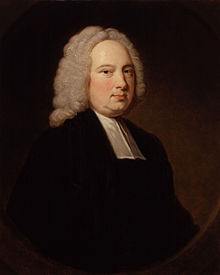James Bradley
| James Bradley | |
|---|---|
 |
|
| Born | March 1693 Sherborne, Gloucestershire, England |
| Died | 13 July 1762 (aged 69) Chalford, Gloucestershire, England |
| Nationality | United Kingdom |
| Fields | Astronomy |
| Institutions |
University of Oxford Ashmolean Museum |
| Alma mater | Balliol College, Oxford |
| Known for |
Aberration of light Astronomer Royal |
| Notable awards | Copley Medal, 1748 |
James Bradley FRS (March 1693 – 13 July 1762) was an English astronomer and priest and served as Astronomer Royal from 1742, succeeding Edmond Halley. He is best known for two fundamental discoveries in astronomy, the aberration of light (1725–1728), and the nutation of the Earth's axis (1728–1748). These discoveries were called "the most brilliant and useful of the century" by Jean Baptiste Joseph Delambre, historian of astronomy, mathematical astronomer and director of the Paris Observatory, in his history of astronomy in the 18th century (1821), because "It is to these two discoveries by Bradley that we owe the exactness of modern astronomy. .... This double service assures to their discoverer the most distinguished place (after Hipparchus and Kepler) above the greatest astronomers of all ages and all countries."
Bradley was born at Sherborne, near Cheltenham in Gloucestershire, to William Bradley and Jane Pound in March 1693. After attending Westwood's Grammar School at Northleach, he entered Balliol College, Oxford, on 15 March 1711, and took degrees of B.A. and M.A. in 1714 and 1717 respectively. His early observations were made at the rectory of Wanstead in Essex, under the tutelage of James Pound, his uncle and a skilled astronomer. Bradley was elected a fellow of the Royal Society on 6 November 1718.
He took orders on becoming vicar of Bridstow in the following year, and a small sinecure living in Wales was also procured for him by his friend Samuel Molyneux. He resigned his ecclesiastical preferments in 1721, when appointed to the Savilian chair of astronomy at Oxford, while as reader on experimental philosophy from 1729 to 1760, he delivered 79 courses of lectures at the Ashmolean Museum.
...
Wikipedia
